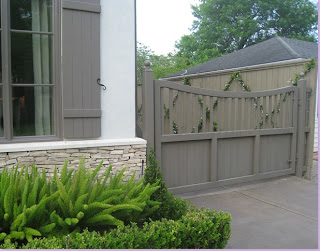Please visit us on Facebook
Purchasing a driveway gate and railings for your garden is an important investment and you will want to know what type of material is best for it. You will want to take into consideration how using a certain material can affect the following:
- Aesthetics
- House value
- Security
- Access
- Automation
- Durability
- Reliability
Timber Gates
Wood is porous, and when exposed to water, it expands and this can sometimes prevent a door from opening and shutting properly. This can be very inconvenient for the opening and shutting of a driveway gate as wood, if unprotected, can expand up to 6 inches in wet seasons.

When the timber is exposed to moisture and has not got a sufficient amount of time to dry, the wood will expand up and out the way causing unsightly mounds on the surface. When exposed to hot or cold dry air, wood contracts. Therefore the constant expanding and contracting of the wood can lead to surface warping and this effects the gates automation system if the gates shape changes over time. Softwood gates and garden furniture are even more susceptible to marks from accidental damage, but this can often result in an appealing weathered quality.
Woods can also be susceptible to wood worm and different types of rot. The term "wood worm" applies to any species of beetle larvae that consumes wood. There are over 300 different species of beetles that can lay their eggs inside wood and once the larvae starts to consume the wood, it leaves small holes in the timber which can leave the wood susceptible to rot and other insect infestations.
 |
| Broad-leaf walnut tree (hardwood) |
Using a hard wood from a broad-leafed tree (without needles) such as oak, walnut or mahogany, can ward of wood worm as the insects will be looking for softer woods from needle bearing trees which are easier to consume such as pine, spruce, redwood or cedar.
 |
| Needle bearing pine tree (softwood) |
Most woods are treated with a 'biocide', which is a chemical substance which deters harmful damage. For example, a 'biocide' used frequently everyday is chlorine, which treats water and prevents harm to the people consuming from the water supply. Unless a wooden gate has been treated by your gate manufacturer, you will need to treat your wooden gates before installation. A recommended wood treatment or 'stain' is Osmo or Sadoline. They offer up to 7 years protection but it is recommended that the gates are re-coated every 18 months with this product.
Metal gates
Metal gates, are however, highly durable. There are usually two main types of metal gates provided by metal fabricators, these are wrought iron or steel. Wrought iron has little carbon content, it is tough, malleable, ductile and easily welded. It was traditionally smelted at a low temperature to produce a sponge like mass of metal called 'bloom', the impurities are then hammered off as 'liquid slag', hence the name, 'wrought iron', which means 'worked iron'. Now that the wrought iron is pure it is not susceptible to corrosion from weathering. Due to the materials durability, it's shape wont alter, this is therefore better for an automation system due to consistently maintained balance, or if the gate is not automated, general access will not be obstructed either.
Steel is an alloy made of iron and carbon. It is not a ductile material, this means it has little ability to deform under tensile stress. This is perfect for gates and garden furniture as it is so durable, but being un-malleable does have its disadvantages when creating intricate designs. Wrought iron is strong and malleable, therefore this material is probably best for creating gates and railings with ornate designs.
 |
| The galvanizing process |
When purchasing a metal gate, other precautions against accidental damage and weathering can be made. One example is putting the metal through the galvanizing process. Galvanizing is the process of coating iron and steel with a thin layer of zinc by passing it through a molten bath at a temperature of 460 degrees Celsius. When exposed to this atmosphere, the zinc reacts with oxygen to form Zinc Oxide, which then reacts further with carbon dioxide to form zinc carbonate.
 |
| Set of galvanized metal railings |
There has been several tests on the durability that hot dip galvanizing has when used in industrial work. Tests have been done on the durability metal has after the galvanization process and then placed in salt water. The results of the test are only good news for those with galvanized gates and railings above sea-level as they are able to withstand harsh sea water for up to 12 years.
Both timber and metal driveway gates and railings give great first impressions and can easily increase a homes value, but before buying either wood or metal, take into consideration your homes' style and your own budget before making the investment. It may be a good idea to have a combination of metal and wood as it would half your maintenance time and effort when re-treating the wood on an annual basis.
For more information, visit our website:
http://www.abbeygates.co.uk/why-choose-metal-garden-gates/
Resources:
*
http://www.galvanizeit.org/about-hot-dip-galvanizing/how-long-does-hdg-last/in-water











